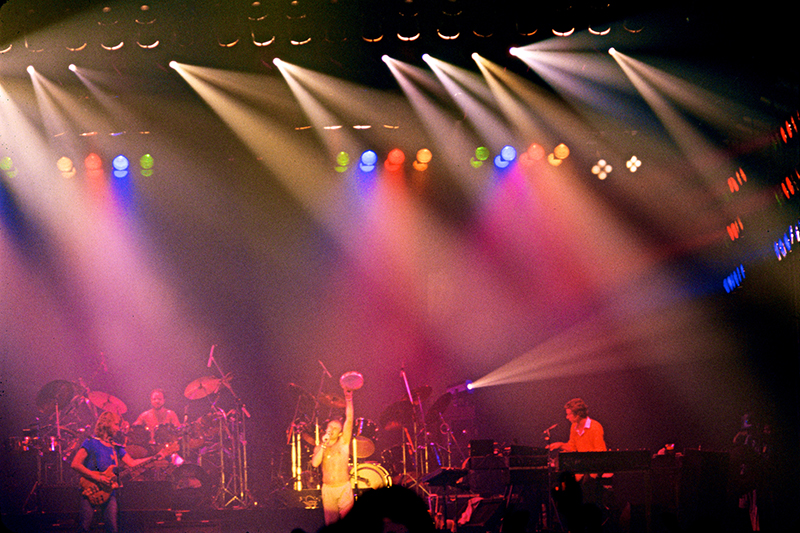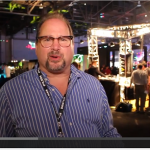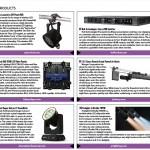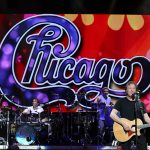
Rusty Brutsche, Jim Bornhorst and Tom Littrell Reflect on the Brand’s Origins 40 Years Ago
The story is legendary. At a barbecue joint in Dallas in the fall of 1980, the prototype of a color changing light fixture was taken to another level when Jack Maxson, a founding partner of sound company Showco, casually suggested: “Add two more motors and it moves.” The development of the first Vari-Lite automated luminaire created its own company when it went into production from a paper sketch to its premiere on Sept. 25, 1981.
The brand continues to shine on with new people and new products, now under the ownership of Signify. But a 40-year history lends itself to some tales of a time when the concert industry was somewhat in the dark, creating its bedrock to build the foundation that endures today.
Tales are meant to be told. PLSN called upon three pioneers —Rusty Brutsche, Jim Bornhorst and Tom Littrell — to reflect on that first fixture, that first control system, and that first tour of the Vari-Lite brand and company.
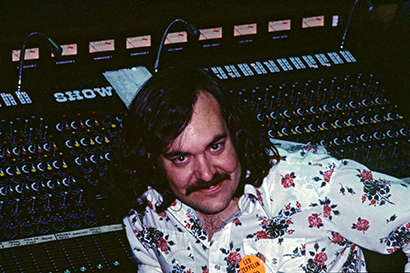
To refresh your memory: Led Zeppelin sound engineer Rusty Brutsche became one of three founding partners in Showco in 1970. He served as president of Vari-Lite International starting in Jan. 1981 with the development of its namesake moving light. After Vari-Lite was sold to Genlyte Thomas, he kept the rental business (VLPS), sold it to PRG in 2004, set up a new R&D group and, after 10 more years with PRG, retired in March of 2013. He’s now enjoying grandfather duties in Austin, TX.
Jim Bornhorst originally joined Showco in 1972 to assist in the development of sound systems, but also created the line of Vari-Lite products. He stayed with Brutsche through company changes to develop Bad Boy, Best Boy and more for PRG. He retired alongside Brutsche in 2013 and resides nearby in Austin, TX.
Tom Littrell put off pursuing his college degree to “temporarily” work at Showco/Vari-Lite in the mid-70s, but by his second tour, Paul McCartney’s 1976 “Wings Over America,” there was no turning back. In 2002, he left the company and joined ETC in Wisconsin, retiring during the 2020 pandemic. He still travels to Texas for the barbecue.

PLSN: What led to the development of the first Vari-Lite moving light?
Rusty Brutsche: We began thinking of a color changer for a PAR can, because with gels, you had to dedicate a bank of lights to each color. We were running out of space above the stage to hang the large PAR can rigs. This was our driving force that started the “gel changer project” that led to the development of Vari-Lite. We tried several ideas that were not successful, so I asked Jim to look at the gel changer problem. His solution was the dichroic color changing system in combination with the metal halide arc lamp. After Jack Maxson’s comment at the barbecue lunch, we added pan and tilt, gobos and dimming to the prototype. As we built the first 50 lights for Genesis, we were still thinking of it as a repositionable light that could be focused remotely without having to climb the truss. We didn’t foresee the kinetic aspect of this. We did not visualize what was going to happen in the shop when Tom Littrell twirled a knob and all 50 lights on the truss moved together in unison. We were all shocked. We thought, “Wow, look at that!” It never really gelled in our brain that this was going to happen.
That is what really made Vari-Lite: the kinetic movement of white light beams in combination with the dichroic color changing system really excited people, and the fact that you could change those dichroic colors so quickly. Also, we’d never seen such saturated colors before, because a saturated gel is still dim. You put a UV filter in front of that arc lamp, and you’ve really got something.
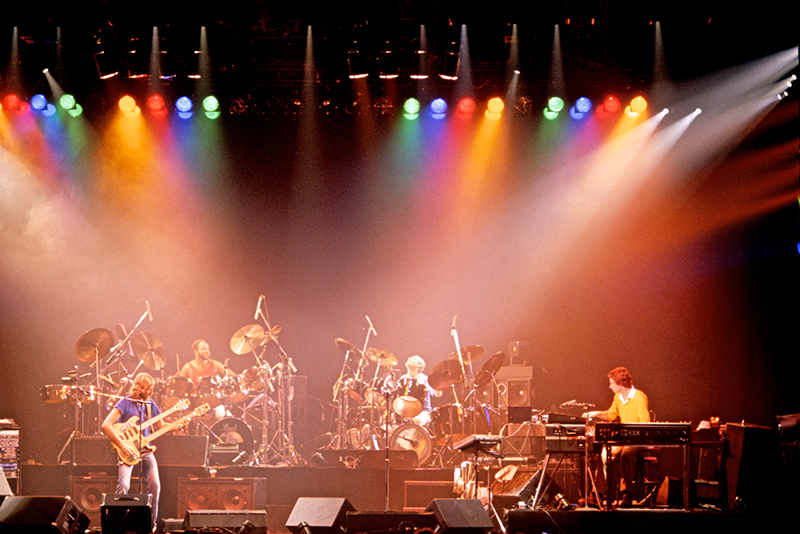
How did Genesis become the first to use the new Vari-Lite?
RB: As Showco, we started working with Genesis in 1971, so we had been working with them for 10 years at that point. The band always did massive, complicated theatrical shows. They always liked new hardware. They had one tour with giant overhead mirrors that they actually moved around.
Tom Littrell: Yes, the 1978 And Then There Were Three tour used mechanical mirrors. They had already used big lasers and video, and Peter Gabriel worked with costumes and scenery and played characters onstage when other rock bands were just playing guitars in a T-shirt. Genesis knew that their music could benefit from the theatrics. They were not musicians who strutted around onstage, they wanted something big around them to serve the music. They were way ahead of their time.
RB: We started working on the new light in the fall of 1980 and built the prototype in three months. In December, Jim and I went to London to show the prototype to Genesis and [manager] Tony Smith at their recording studio. [Lighting designer] Alan Owen also went with us. It was wintertime, and a cold 30 degrees or so. The recording studio was an old house they’d converted out in the country, and they asked Jim to set up the light in the barn. The barn was 500 or 600 years old, with giant oak beams across the top. We tried to screw the lights to the wooden beams, but the wood was like steel, it was petrified. So we roped the light to the beams. It was just one light. Tom Walsh was one of the other engineers on the team, and he developed a control system for it with a serial data link that controlled all of the parameters for the single prototype unit. So we programmed the single light to shine from one wall to the other and change colors. The band was blown away. After the demo, Tony Smith and I were sitting around the fire having a cocktail. We struck the deal, and he basically gave me half of a million dollars. That was the most money I’d ever seen in my life. And he gave it to me without any contracts; we did not have time for any of that. That was in December 1980. The ABACAB tour was starting the next September. I promised to deliver the new lights. We had nine months.

I have a vivid memory of flying back from that London meeting to Dallas. While we’re chatting on the plane, Jim has a drink and cashews and he casually looks over at me and says, “Well, you know it isn’t going to work. We’re going to have to come up with something different for the lights on the tour.” I looked at him and I said, “What?” I’m thinking about all this money from Tony Smith and our promises to build these lights.
But Jim was right. He changed the fixture from a wash light with the pivoting dichroic filter design to a spotlight with color wheels. This was the basis of the VL1’s design; a family of dichroic filters mounted on wheels that, when used in various combinations, provided 60 different colors. Do you remember how many wheels, Jim?
Jim Bornhorst: Yes, three color wheels and one gobo wheel.
RB: We managed to source all those parts. We worked 24 hours, seven days a week and we got that first system built. That was a tribute to everyone in the company who made it happen. And it turned out to be the best business deal I ever made.
Who came up with the name Vari-Lite?
RB: When we were making our deal, I asked Tony Smith what we should call this, and he said Vari-Lite, and I said, “That sounds good.” It was interesting, Vari-Lite came into being from the first idea to the Genesis show in 12 months. Unbelievable.
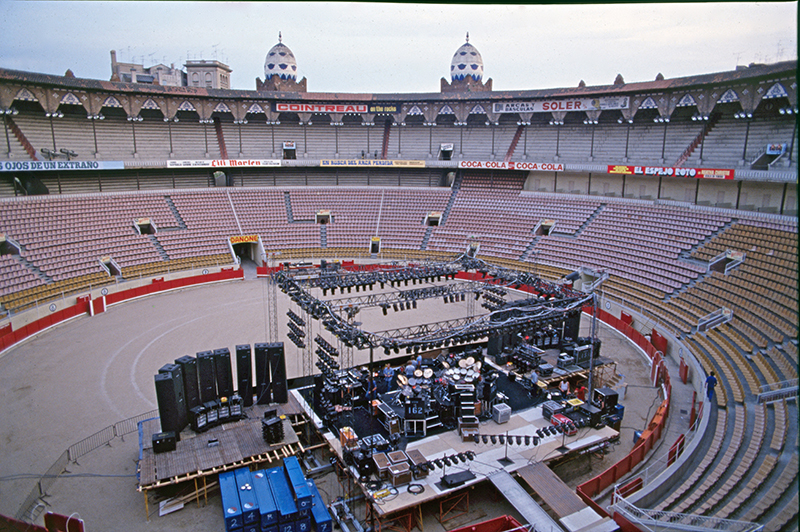
“It was Dusty, Smelly and Hot”
Reflect on that historic premiere of the first Vari-Lite fixture. It was Sept. 25, 1981, the start of Genesis’ ABACAB tour at the Plaza de Toros Monumental bull fighting ring in Barcelona, Spain.
JB: I remember it so vividly. The place was packed. It was dusty, smelly and hot. I remember standing at our console with Brooks Taylor, Tom Littrell and Alan Owen. It was two or three songs into the set, during “Dodo,” when Tom and Alan first showed the Vari-Lites. It came at a crescendo in the song, and all of the lights in the back truss just swept out beams into the audience, all in one color. The place erupted, with everyone jumping up and down. I remember thinking, ‘Holy moly, this may really be something!’ The dust level rose like a fog on the floor. Remember that, Tom?
TL: Absolutely. We had smoke machines but didn’t need them because the air was thick with dust anyway. I also won’t forget the smell of the bullring.
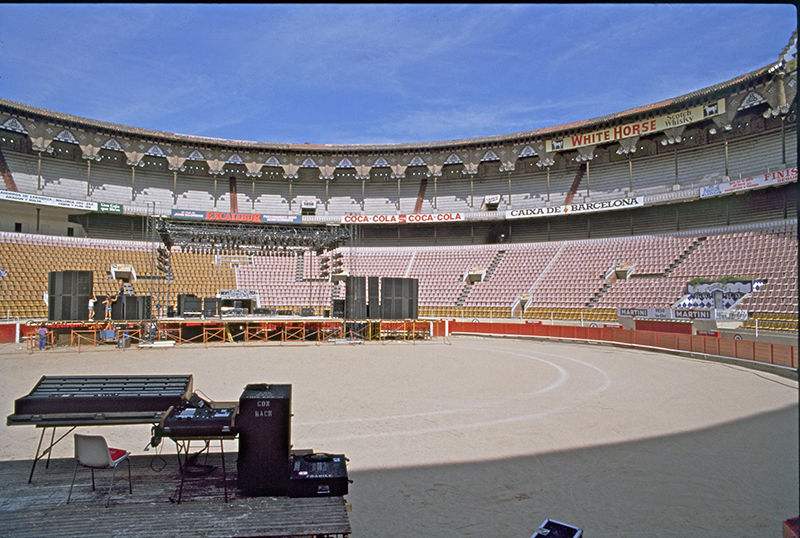
JB: It was a big set, there was a lot of gear and the stage was pretty rickety. My gig was to get the power rigged up for the Vari-Lite system. Those first systems wouldn’t run on 240 volt power, so we had a giant 75 kVA transformer that was fed by 3-phase power. I was trying to communicate with Spanish stage hands who spoke little to no English and all I had was a handful of words in TexMex, trying to come up with 3-phase power to power the transformer.
TL: They absolutely could not locate a transformer in Europe to be booked for the length of the tour, so we had to ship a 1200-to 1500-pound “lump of iron” of a transformer. I was getting ready to fly to London for rehearsals. When I got to the airport, they charged an extra $1,200 on my plane ticket because the transformer had to go as excess baggage. On the plane, we’re told the flight would be delayed 45 minutes because “a large, very heavy piece of late-arriving baggage has delayed the loading of the plane” because they had to completely reconfigure the cargo. I paid that credit card bill pretty quickly, and because of that, I got an invitation to become an American Express gold card member!
On the tour, as word spread, every other night a lighting designer came to see the lights. Tour dates became a destination for lighting folks.
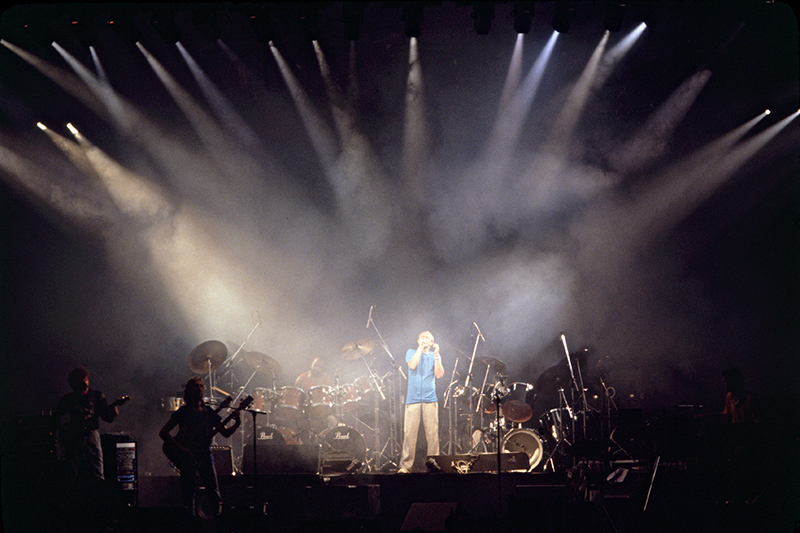
What was the difference in operating a show using the first moving lights compared to using conventional fixtures?
TL: Sadly, we lost Alan Owen, Genesis’ longtime lighting designer, in 1996 from cancer. For that tour, Alan ran the console with the conventional PAR cans, and I ran the console for the Vari-Lites. In the early 1980s, a lot of rock ‘n’ roll lighting was still “make it up as you go along.” With moving lights, you can do that, but you have to be really good at busking, and none of us were good then. Genesis’ music is theatrical, so it always lent itself to being a cued show.
RB: It [the VL1] was very unreliable. We struggled to keep lights working. We spent lots of time repairing and replacing components.
TL: We started needing people quickly. We took experienced road guys — and there were some women as well — who had technical ability or were able to learn the technical side of it. We also hired students from places like DeVry Institute of Technology. By 1981, most concert touring folks were already much more than the stereotypical road-dog roadie. The challenge of sleeping on the bus, pulling up to an arena at 6 a.m. with five to 10 trucks of full of gear and making it all work by 6:30 at night, working 16-hour days — it took talented, technically trained and dedicated folks to get shows up and down every day. And we needed more of them.

Setting Industry Standards For Control
We can’t talk about the first Vari-Lite without discussing the development of its first control system.
TL: Jim Bornhorst, Tom Walsh, John Covington and Brooks Taylor are the actual human beings behind the name Vari-Lite, who created all this stuff and made it work. That first console by today’s standards was incredibly rudimentary, but it started doing things that they still do with moving lights today. The idea that you didn’t have to worry about which channel was pan and tilt and intensity — all you had to do was select a fixture and the console knew about pan and tilt and color and which knobs you had to make that work on. You didn’t have to think about channel numbers. The console did that for you. The idea of color palettes: you didn’t have to recreate a color red every time you wanted to use it. You could make your color red and store that on a palette button and recall it every time you wanted it. There were things that Brooks Taylor came up with that are still done on consoles in exactly that same way today.
RB: Tom Walsh designed the Vari-Lite control system. It was a computer system that was a derivative of a disco dance floor controller that we developed for The Bee Gees’ touring stage in 1979. Tom had become familiar with a certain type of microprocessor. When we came up with the design for the very first Vari-Lite system, he used the same processor. He used what’s called wire wrap technology. He made all of this hardwired instead of using normal circuit board technology. [Editor’s note: As an alternative to soldering, wire wrapping technology was a safe and efficient means to connect wires to terminals.] But I remember he did it sitting at a desk with paperwork for the various components laid out around him. In his mind, he was able to wire wrap these boards and make it all work. It was a miracle — a 32-channel board with 32 push buttons, one for each channel. And then pan and tilt, gobos and dimming. Brooks Taylor wrote all the software himself. Jim, explain how the paper tape system worked.

JB: Brooks wrote it in assembly language [low level programming language], because there was no high level computer language developed at that time. This was at the early stages of the microprocessor. So Tom Walsh had developed the computer system around a little 8-bit RCA microprocessor, actually five of them. But he also had to build a development system that would take Brooks’ code in assembly language and translate it into machine language for these processors. Five processors ran in parallel with a shared memory; each had its own operating system and they all had to mesh together. Brooks could see all this in his mind, and he had to create the code. He would type the code in assembly language into a teletype machine that spit out a paper tape. That’s what ASCII code is, the 8-bit character string that is on your keyboard and is still in use today — it came from a teletype machine. So it spit out this paper tape, you had rolls and rolls of them, and Walsh’s computer, which was based on an IMSCI8080 8-bit processor, would read this tape and change it from assembly language to machine code, and that would be loaded into EPROMs [erasable programmable read only memory] and would then be plugged into these processors. So those two guys’ brains working together — to me, it was a frigging miracle because I wasn’t digitally savvy. Actually, the console was far more reliable than the lights were.
RB: I consider Tom Walsh as the Wozniak of the Vari-Lite world. He was not a degreed, formally trained engineer, he was a first chair violinist studying at the University of Indiana, and when he decided he was never going to be the best violinist in the world, he stopped playing. His father was an engineer, so he picked up some things from him; he is a self-taught genius. I agree that Tom Walsh and Brooks Taylor were the two unsung heroes of this, because they made this control system work, and that was the thing that made the lights do that sweep and enabled all the choreographed moves.
JB: The first console had only 32 control channels, so we set several lights in the Genesis system to the same communications address. They performed as a pair executing the same data. We built only the one console of this design. The next generation console had 100 control channels and a TV monitor.

“The Shot Heard ‘Round the World”
Genesis promoted the exclusive use of the Vari-Lite system in their press kits back then. How did that impact your touring business?
RB: The impact was like the shot heard ‘round the world. I was getting phone calls and there was lots of excitement, but some people thought it was a flash in the pan, a special effect. “Gee, that’s nice, but it’s not really going to last.”
I had to work at it to get other artists to use the system. One of the first lighting designers was Allen Branton with Diana Ross. The other was ZZ Top. I knew Billy Gibbons really well, and we had done his sound for a long time. He was an eccentric guy and he liked the idea of Vari-Lite, so the band used us on their early tours.
But Tony Smith was a great partner; we stayed partners for 30 years. He put more money into the company as we grew. Genesis was not only proud of it, but for the next 10 years, they built their show around Vari-Lite. So we had the first tour in 1981 with 50 lights plus five spares. We ended up using only 44 lights in the rig and used 10 lights as spares, and the final light ended up being a sacrificial lamb and got taken apart for parts. Those first lights were like VL1s, but they were actually the precursors to VL1s. They weren’t VL0 and they weren’t VL1, they were in between — like a VL 7/8ths. We kept rebuilding the lights over and over again. Didn’t we rebuild it like six times, Jim? Six versions of the VL1?

JB: Yes, it was redesigned to fix a myriad of problems. Some things got better, and some things didn’t. Everyone thought that the dichroic filters we had in the first 55 that we built had the best color palette that we ever had.
TL: It was the fastest color change that ever was.
JB: Yes, it would click to any color in the system at a tenth of a second. It was faster than the human eye could see. That was actually one of the most phenomenal effects, to have all those lights change color in an instant. It sounds simple, but the impact was tremendous.
RB: That effect had never been seen. Color change had never been possible. It was really powerful. And you add the pan and tilt movement to it, and it was really something. We did the Genesis ‘82 tour with 150-plus VL1s, and then the ‘83 tour was a really big rig.
TL: The ‘83 tour had the big hexagonal rig with close to 300 VL1 fixtures.
RB: That was the tour that really put us on the map in the industry. When people saw that rig, it was mind boggling. We did that video of it that we used for promotions, and the floodgates opened. People could see that it was the future. I was able then to begin an international expansion. During 1983 to 1984, we opened offices in Australia, London and Japan. From there, we opened European offices and expanded throughout the U.S. The Vari-Lite enabled us to become an international company very quickly. By the end of the 1980s, we were the largest rental company in the industry, and the only one located worldwide. It was all on the back of the Vari-Lite technology and what it had to offer.
